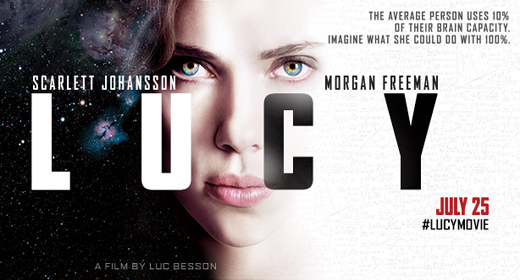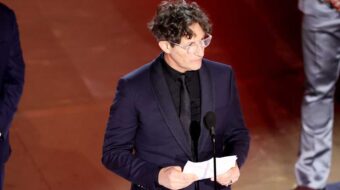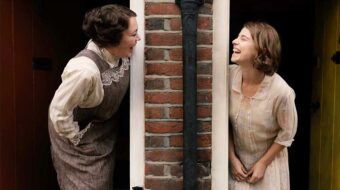
Writer/director Luc Besson’s Lucy is arguably the most visually visionary science fiction movie since Stanley Kubrick’s 2001: A Space Odyssey. Scarlett Johansson portrays the title character, a foreign student studying at Taipei who is ensnared in a bad drug deal with Taiwanese mobsters. This leads to her ingesting a high dose of a chemical substance called CPH4 that causes Lucy to become hyper-intelligent.
This extraordinarily optically opulent film combines two of Besson’s obsessions: Powerful female protagonists and sci fi. Besson’s previous films include The Fifth Element, La Femme Nikita, and The Lady, the biopic about Burmese pro-democracy leader Aung San Suu Kyi.
Besson’s graphic depiction of Lucy’s state of extreme ultra-cosmic consciousness is highly cinematic in this film full of stunning cinematography and Sergei Eisenstein-like montage sequences (not so much in terms of their timing but in regard to associational editing). It’s interesting that the more intelligent Lucy becomes the more violent she is — one of the movie’s many Kubrickian references. (In 1971’s A Clockwork Orange the thuggish droogie Alex [Malcolm McDowell] may behave like a soccer hooligan, but he’s highly intelligent and a fan of Ludwig van Beethoven.)
Lucy is — as Johansson’s character is reminded — also the name of our oldest human-like ancestor, who is glimpsed onscreen at various points in the movie. Her name may also be a reference to the Beatles’ “Lucy in the Sky with Diamonds,” especially given the film’s psychedelic cinematography. Lucy becomes a character similar to the savior-like “star child” Dr. Dave Bowman is transformed into at the end of 2001; during Lucy’s end credits (which, remarkably, include the names of every musician who contributed to the movie’s soundtrack) the lyrics of a song are about a “messiah.”
Besson has previously helmed action-packed flicks such as Nikita (about a female assassin), and unfortunately Lucy is full of screeching car chases and blazing gunplay. Although Besson has demonstrated a penchant for violent films, this may be intended as box office insurance to lure the multi-plex and male adolescent crowds to buy tickets and popcorn. Given its sidewalk cafes, bookstalls and roundabouts, Paris is the world’s worst city for driving at high speed on the streets (especially since this is the first time Lucy has ever driven a car, as she tells detective Pierre Del Rio, played by Cairo-born Amr Waked). Besson should leave the mindless explosions to lesser directors like Michael Bay. They intrude on and mar what could have been a more philosophical sci fi cinematic treatise on the nature of knowledge, which, as Lucy shows, is flawed if not accompanied by compassion — therein lies true wisdom. The movie’s negative depictions of Asians also leaves much to be desired.
Scarlett Johansson is fine as the CPH4 amped-up action star and genius who uses 100 percent of her brain power. Morgan Freeman co-stars as a scientist and it’s fun to see Danish actor Pilou Asbæk — who plays the troubled spin doctor in the superb Borgen TV series about Denmark’s first woman prime minister and co-starred in the 2012 movie A Hijacking — in a smarmy cameo role as Lucy opens. Lucy is for fans of Johansson, female action parts, sci fi and, above all, ecstatic cinema that imaginatively uses the attributes of the motion picture medium to the max.












Comments